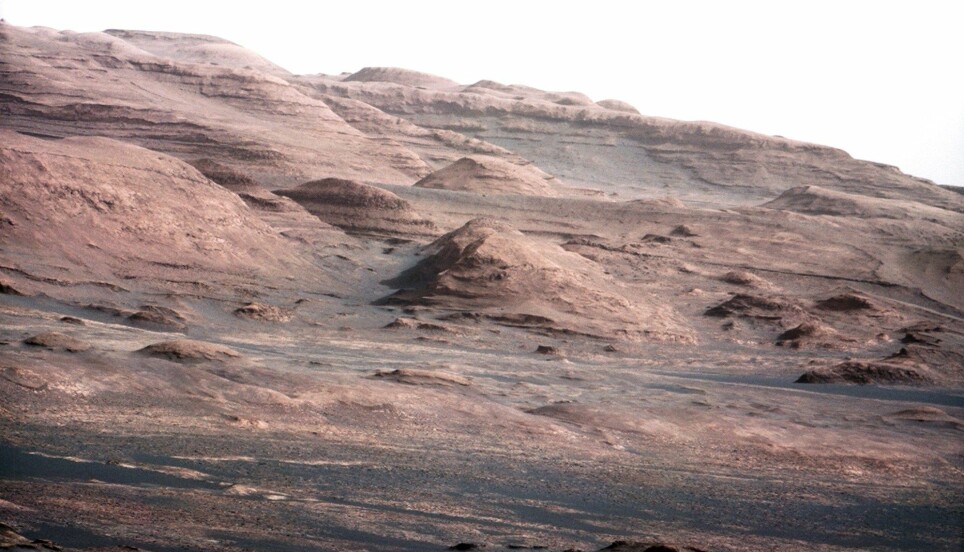
Study finds signs of ancient megafloods on Mars – pure speculation, says professor in Norway
Based on images from the Mars rover Curiosity, researchers believe floods of unimaginable magnitude once washed over Mars. “They’re trying to justify a lot of things that you can’t really know based on a few pebbles”, says professor at the University of Oslo.
The ancient megafloods are to have happened on Mars about 3,6 billion years ago, in the Gale Crater, where NASA’s Curiosity rover landed.
In the middle of the crater we find Mount Sharp, a central peak in the crater.
According to the American researchers behind the new study, analyses of sediments in the crater suggest that great floods washed through the area.
“We identified megafloods for the first time using detailed sedimentological data observed by the rover Curiosity,” said co-author Alberto G. Fairén, a visiting astrobiologist in the College of Arts and Sciences.
The megafloods are to have left behind giant wave-shaped features in the Gale crater, often called ‘megaripples’, which the researchers have identified.
Heavy rain after sudden ice melt
The American researchers believe that an asteroid hit the surface of Mars about 3,6 billion years ago. This in turn generated so much heat that the ice formed vapor clouds. At the same time, greenhouse gases like CO2 and methane were released from the ice and created pressure in the atmosphere. This could have caused heavy rainfalls, possibly over the entire planet.
The water is to have flooded into the Gale Crater, as well as down from the peak of Mount Sharp – and when these masses of water hit each other, gigantic flash floods occurred.
The researchers believe the finding can say something about how the climate on Mars developed in the planet’s early history.
But not everybody is convinced by the conclusions of the new Mars-study.
“Full of speculation”
“The study is full of speculations”, says Stephanie Werner. She is a professor in the Centre for Earth Evolution and Dynamics of the University of Oslo, and is known for her work on Mars and the Arctic.
First of all, the American researchers assume that the sediments they have found were created after the mountain of Mount Sharp came to be. But there is no evidence of this, says Werner. The hill in the middle of the crater might as well have occurred after the sediments that the researchers are studying.
And secondly, Werner doubts that very much water can have accumulated from Mount Sharp, as the mountain does not cover a large area and cannot catch a lot of water.
Not early Martian history
Werner also finds the suggestion that these giant floods can tell us something about climate in early Martian history to be very speculative.
In the planet’s history, 3,6 billion years ago isn’t early. The planet had then already existed for 1 billion years, she points out.
“They have a lot of details, but when they put them in the big context of Mars’ evolution, I would say they are trying to justify a lot of things that you don't justify with a few pebbles”, Werner says.
Proof of running water on Mars
There is water on Mars today, in the form of ice. Ice covers the two poles on Mars, but is also found in other places on the planet.
Liquid water cannot exist on today’s Mars, with a temperature of on average minus 60 degrees Celsius, and a very thin atmosphere.
However, there is evidence that suggests liquid water and floods have appeared on Mars earlier.
Werner talks about two different formations in the landscape of the red planet, where researchers believe there once was liquid water.
One is traces of ancient rivers, while the other looks like a mix of large canals and landslides, according to Werner.
The knowledge we have as of today suggests that there was indeed liquid water on Mars about 3,6 million years ago. And that already back then, the planet’s climate seemed to be going through changes.
“Why the atmosphere of Mars changed is still a question researchers are trying to answer”, says the professor.
Translated by: Ida Irene Bergstrøm
Reference:
E. Heydari med flere: Deposits from giant floods in Gale crater and their implications for the climate of early Mars, Scientific reports 2020, https://doi.org/10.1038/s41598-020-75665-7
———































